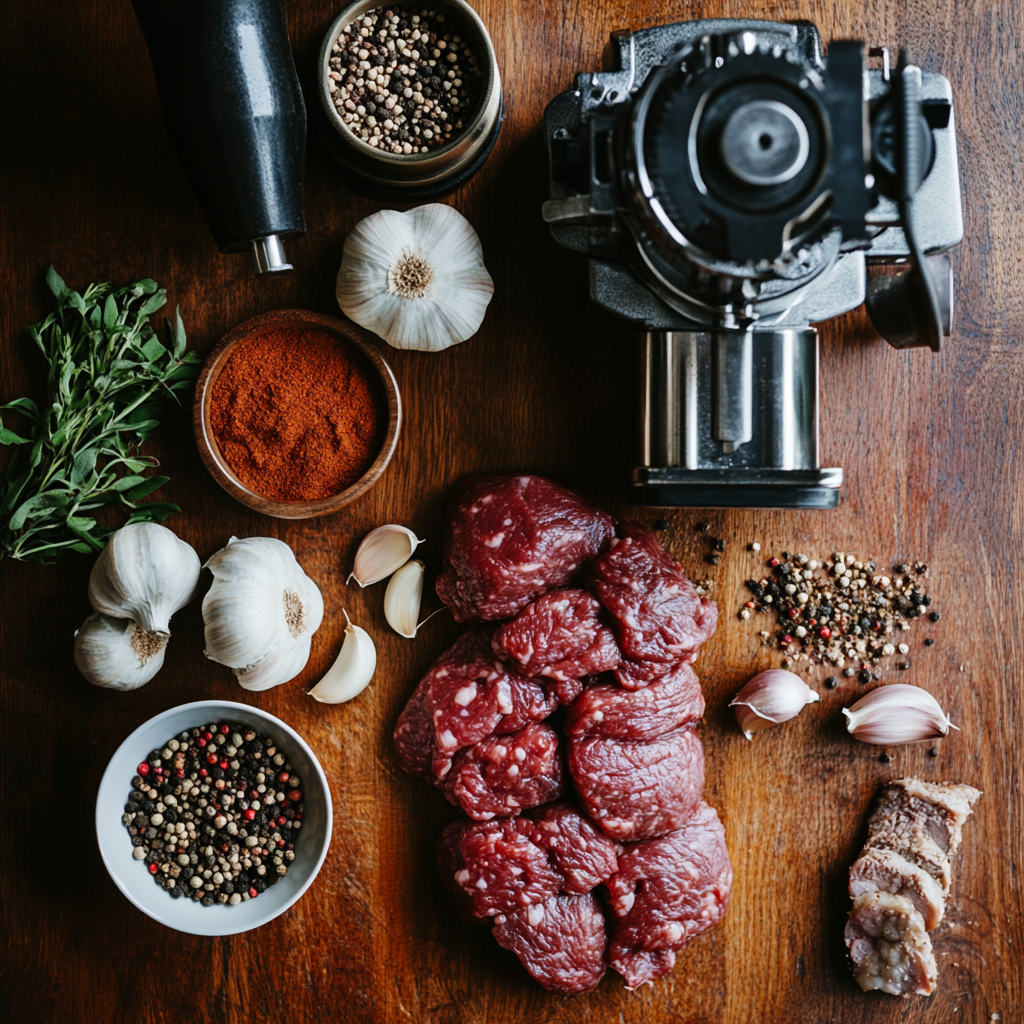Why Beef Sausage is a Staple in Global Cuisines
Homemade beef sausage is a timeless favorite that brings rich, savory flavors to any meal. Whether grilled for a barbecue, pan-fried for breakfast, or added to hearty stews, this versatile dish is a staple across global cuisines. Making beef sausage at home allows you to enjoy unmatched freshness and tailor the flavors to your liking, creating a personal touch in every bite.
Part of its universal appeal lies in its bold, savory flavor, which pairs beautifully with a variety of ingredients and spices. Whether you prefer it with a crispy, golden crust straight off the grill or incorporated into a flavorful stew, beef sausage has a way of bringing people together around the table.
Homemade vs. Store-Bought Beef Sausage
While store-bought beef sausage offers convenience, making it at home provides unparalleled control over ingredients and flavor. Homemade recipes allow for customization of spice blends, fat content, and even regional twists, resulting in a healthier and more satisfying culinary experience. If you’re inspired to create your version, consider this step-by-step guide to cooking beef at home, where fresh ingredients make all the difference.
On the other hand, store-bought sausages often prioritize shelf life, sometimes sacrificing taste and quality. By crafting your own sausage, you can experiment with regional flavors, dietary preferences, and premium cuts of meat. Plus, there’s something deeply satisfying about preparing this beloved staple from scratch and sharing it with loved ones.
Essential Ingredients for Beef Sausage

Crafting the perfect beef sausage begins with selecting high-quality ingredients. Each component plays a crucial role in creating the savory, juicy flavors and the satisfying texture that make beef sausage a favorite in cuisines worldwide.Check out top beef recipes for every occasion to explore diverse preparation methods.
Selecting the Right Cuts of Beef
The foundation of any great beef sausage is the meat itself. Opt for well-marbled cuts like chuck or brisket, which strike the ideal balance between lean meat and fat. The fat content is essential for creating a moist and flavorful sausage, ensuring it doesn’t dry out during cooking. Avoid cuts that are too lean, as they can result in a dry and crumbly texture.
When choosing beef, freshness is key. Look for bright red meat with a firm texture and minimal odor. If possible, grind the meat at home or have it freshly ground at your butcher to guarantee optimal quality.
Importance of Fat Ratio
The fat-to-meat ratio is a critical consideration in sausage-making. A ratio of 70-80% lean meat to 20-30% fat is widely regarded as the sweet spot for achieving juicy, flavorful sausages. The fat not only enhances the taste but also acts as a binding agent, contributing to the sausage’s smooth texture.
If you prefer a leaner sausage, you can reduce the fat content slightly, but be mindful that going too low can compromise the overall quality. For those who want to experiment, consider adding beef tallow or mixing in small amounts of pork fat for added flavor complexity.
Seasonings and Spices
What sets a beef sausage apart is its unique seasoning blend. A traditional recipe typically includes salt, black pepper, garlic powder, and onion powder as the base. From there, you can customize the flavor profile with additional spices:
- Paprika for a mild smoky taste.
- Cumin for earthy, warm undertones.
- Fennel seeds for a hint of sweetness.
- Cayenne pepper or chili flakes for a spicy kick.
Fresh herbs like parsley or thyme can add brightness, while dried herbs provide depth. Be generous with your seasoning; sausage needs bold flavors to shine.
Ingredient Substitutions and Dietary Alternatives
If you have dietary preferences or specific ingredient restrictions, there are plenty of options to keep your sausages flavorful. Replace regular salt with low-sodium alternatives or use smoked salt for a unique twist. For a lower-fat option, mix in ground turkey or chicken with lean beef, though you may need to add a touch of olive oil to maintain the sausage’s moisture.
Vegetarian or vegan adaptations can also be made by substituting the beef with plant-based proteins like textured vegetable protein (TVP) and using coconut oil or a similar fat alternative.
Step-by-Step Guide to Making Beef Sausage at Home

Making beef sausage at home might seem intimidating at first, but with the right tools, ingredients, and a little patience, you can master this rewarding process. Follow these detailed steps to create savory, flavorful sausages that rival store-bought options.
1. Preparing the Meat and Equipment
Start by ensuring that your equipment is clean and ready for use. You’ll need:
- A sharp knife
- A meat grinder or food processor
- A sausage stuffer (manual or electric)
- Casings (natural or synthetic)
Step 1: Cut the Beef
Begin by cutting the beef into small, manageable chunks, about 1-inch cubes. This makes it easier to grind and ensures even consistency. If using a beef cut with limited fat, add some extra fat trimmings to the mix.
Step 2: Chill Everything
Cold temperatures are crucial for sausage-making. Place the meat, fat, and grinder attachments in the freezer for 20-30 minutes before grinding. This prevents the fat from melting and helps maintain the desired texture.
2. Grinding and Seasoning the Meat
Step 1: Grind the Meat
Pass the chilled meat and fat through the grinder using the coarse plate first. For a finer texture, grind it a second time using the medium or fine plate.
Step 2: Mix the Seasoning
Combine your spices and seasonings in a bowl. Be sure to measure accurately for consistent flavor. Add the seasoning to the ground meat, mixing thoroughly until evenly distributed. You can use your hands for this step, but work quickly to keep the mixture cold.
Step 3: Test the Flavor
Before stuffing, cook a small portion of the sausage mixture in a skillet. Taste and adjust the seasoning as needed. This step ensures your sausage is perfectly seasoned.
3. Stuffing the Sausage Casings
Step 1: Prepare the Casings
Soak natural casings in warm water for at least 30 minutes. Rinse thoroughly to remove any salt and check for holes by running water through them. Synthetic casings often come ready to use, so follow the manufacturer’s instructions.
Step 2: Attach the Stuffer
Place the casing over the nozzle of your sausage stuffer, leaving a few inches of the casing unfilled to tie off later. Fill the stuffer with the sausage mixture.
Step 3: Fill the Casings
Turn the stuffer slowly and evenly, guiding the casing as it fills. Avoid overstuffing, as this can cause the casing to burst. Twist the sausage at regular intervals to form individual links.
4. Cooking and Storing Beef Sausage
Step 1: Cooking Options
Beef sausage can be cooked in various ways:
- Grilling: Cook over medium heat, turning frequently for even browning.
- Pan-Frying: Add a small amount of oil to a skillet and cook on medium heat until browned on all sides.
- Oven-Baking: Bake at 375°F (190°C) for 20-25 minutes, flipping halfway through.
Ensure the internal temperature reaches 160°F (71°C) to guarantee the sausage is fully cooked.
Step 2: Storing Your Sausage
Fresh sausages can be refrigerated for up to three days or frozen for up to three months. To freeze, wrap individual links in plastic wrap or parchment paper and store in an airtight container.
Common Mistakes to Avoid
Making sausage is a precise process, and even small missteps can impact the final product. Here are some common mistakes to watch out for:
- Overheating the Meat: Always keep your meat and equipment cold to avoid melting the fat and ruining the texture.
- Overmixing: Mixing too vigorously can break down the meat proteins, making the sausage too dense.
- Overstuffing the Casings: Leave some room for expansion during cooking to prevent bursting.
- Skipping the Flavor Test: Always test your seasoning blend before stuffing to avoid bland sausages.
Customizing Your Beef Sausage
One of the greatest benefits of making beef sausage at home is the freedom to tailor it to your taste preferences and dietary needs. From bold international flavors to healthier options, the possibilities are endless.
1. Regional Variations and Flavors
Every culture brings its unique spin to sausage-making, often defined by its traditional spices and ingredients. Here are some popular styles you can recreate:
- Italian Beef Sausage: A classic blend of fennel, garlic, and red pepper flakes. Add oregano and a hint of paprika for a deeper flavor.
- Merguez: This North African favorite combines ground beef with harissa, coriander, cumin, and garlic for a spicy, aromatic profile.
- Boerewors: A South African specialty featuring a mix of beef, pork (optional), coriander, cloves, and nutmeg. This sausage is often coiled and grilled.
- Mexican Chorizo: Incorporate smoked paprika, chili powder, and vinegar for a tangy, smoky taste.
Experiment with these recipes or create your own signature spice blend by drawing inspiration from your favorite cuisines.
2. Dietary Modifications and Alternatives
If you’re looking for ways to make your beef sausage healthier or suitable for special diets, there are plenty of options to explore:
- Low-Fat Sausage: Use lean cuts of beef and add a small amount of olive oil to maintain juiciness without adding too much fat.
- Gluten-Free Sausage: Ensure that all spices and casings used are certified gluten-free, and skip any binding agents like breadcrumbs.
- Spice Adjustments: If you prefer a milder sausage, reduce or eliminate spicy ingredients like cayenne pepper or chili flakes.
For a plant-based alternative, substitute ground beef with textured vegetable protein (TVP) or a mix of lentils and mushrooms. Use coconut oil or a similar fat substitute for richness and bind the mixture with flaxseed or breadcrumbs.
3. Pairing and Presentation Ideas
A well-prepared sausage deserves an equally enticing presentation. Pair your beef sausage with these serving suggestions:
- Breakfast: Serve with scrambled eggs, hash browns, and a side of toast for a hearty morning meal.
- Grill Party: Pair with grilled vegetables, coleslaw, and mustard for a backyard feast.
- Comfort Food: Add sliced sausage to pasta dishes, casseroles, or stews for an extra layer of flavor.
For plating, arrange the sausages on a rustic wooden board, garnished with fresh herbs and paired with dipping sauces like mustard or aioli.
Frequently Asked Questions (FAQ)
1. Can I use any cut of beef for making sausage?
Yes, but it’s best to choose cuts with some fat, like chuck or brisket, to ensure your sausage is juicy and flavorful.
2. Do I need to use casings for homemade sausage?
Not necessarily. You can shape the sausage mixture into patties or logs if you prefer a casing-free option.
3. How do I prevent sausage casings from bursting?
Avoid overstuffing the casings and prick small holes in the sausage to release trapped air.
4. Can I freeze homemade sausage?
Absolutely! Wrap the sausages individually and store them in an airtight container or freezer bag for up to three months.
5. What’s the best way to cook beef sausage?
Grilling, pan-frying, or baking are popular methods. Ensure the internal temperature reaches 160°F (71°C).
6. How do I know if the seasoning is right before stuffing?
Cook a small portion of the mixture in a skillet to taste-test. Adjust spices as needed before proceeding.
For additional insights into sausage-making and its broader context, you might find this Wikipedia article on beef sausage useful. It offers a comprehensive look into its history, varieties, and cultural significance.
Conclusion
Making beef sausage at home is a rewarding experience that lets you customize flavors, ensure freshness, and enjoy a healthier alternative to store-bought options. With the right ingredients, techniques, and a little creativity, you can craft sausages that suit any taste or occasion. Try this recipe, and share your culinary masterpiece with friends and family today!

